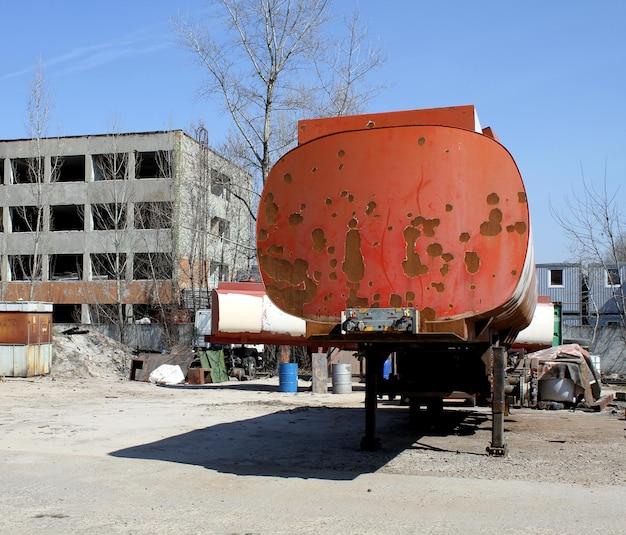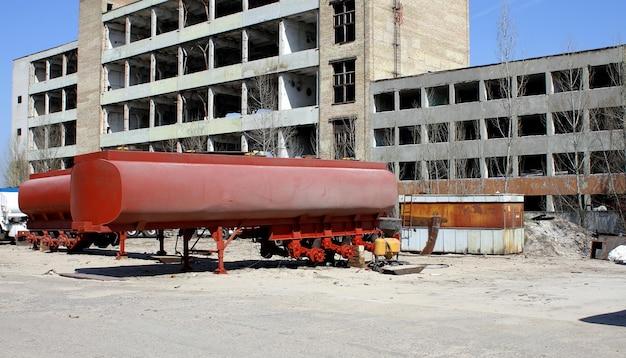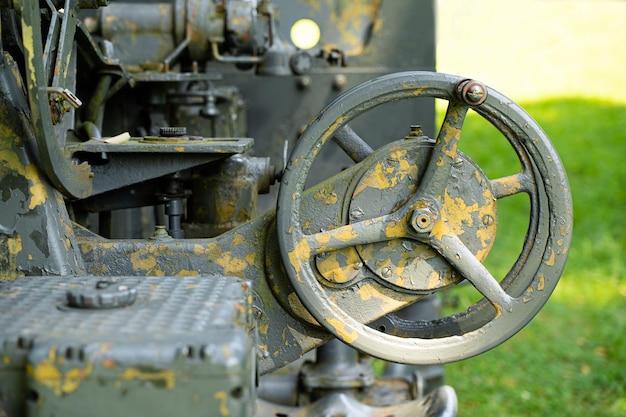If you are a homeowner who is planning to buy or sell a property, you might have come across the term “oil tank decommission.” But what does it mean, and why is it essential?
Over the years, underground oil tanks have become a threat to the environment, especially if they are not appropriately maintained or have exceeded their lifespan. The risks associated with such tanks can result in soil contamination, groundwater pollution, and other environmental hazards.
In this comprehensive guide, we will cover everything you need to know about oil tank decommissioning. We will delve into the regulations surrounding underground oil tanks and help you understand the cost implications of removing a buried oil tank.
But what do you do with a decommissioned oil tank? What are the records required, and when did people stop using underground oil tanks? We will answer all these questions and more in this post.
Whether you are a home buyer, seller, or an environmental enthusiast, this ultimate guide will provide you with the necessary information to make informed decisions. So, strap on and read on as we embark on a journey to uncover the mysteries of oil tank decommissioning.
The Importance of Oil Tank Decommissioning
If you own an oil tank, it’s crucial that you understand the importance of proper oil tank decommissioning. Decommissioning is the process of removing an oil tank from a property, cleaning it thoroughly, and disposing of the tank and any remaining oil in a safe, environmentally-friendly manner.
Oil tank decommissioning is essential for several reasons, including:
1. Prevent Environmental Damage
Oil tanks that have not been properly decommissioned can leak oil into the soil and groundwater, causing harm to the environment. The oil can also seep into nearby bodies of water, affecting marine life. Decommissioning ensures that any remaining oil is safely removed and disposed of to prevent environmental damage.
2. Comply with Regulations
Depending on where you live, there may be legal requirements for oil tank decommissioning. Failing to comply with these regulations can result in fines or legal action. It’s essential to check with your local government to determine the requirements for oil tank decommissioning.
3. Increase Property Value
If you ever plan to sell your property, an old oil tank can significantly decrease its value. Potential buyers may be hesitant to purchase a property with an old oil tank due to the potential environmental risks. Properly decommissioning the oil tank can increase your property’s value and make it more attractive to buyers.
4. Ensure Safety
Old oil tanks can be a safety hazard, especially if they are located underground. Decommissioning ensures that any remaining oil is removed, preventing the risk of fire or explosion.
Oil tank decommissioning is essential for protecting the environment, complying with regulations, increasing property value, and ensuring safety. Don’t wait until it’s too late; if you have an old oil tank on your property, contact a professional to have it properly decommissioned today.
Cost to Remove Buried Oil Tank
If you have an oil tank buried on your property, you may be wondering about the cost associated with having it decommissioned and removed. The cost of removing a buried oil tank can vary depending on several factors. Below are some important things to consider when determining the cost of removing a buried oil tank.
Factors That Influence Cost
Tank Location
The location of the oil tank is a significant factor that can influence the removal cost. If the tank is located in a challenging or hard-to-reach location, it can increase the overall cost of removal. This is because special equipment or excavation techniques may be required to reach the buried oil tank.
Tank Size
The size of the tank is another significant factor that can impact the removal cost. Larger oil tanks may take longer to remove and require more manpower or equipment, leading to a higher cost.
Soil Contamination
If the soil surrounding the buried oil tank is contaminated, additional excavation and cleanup may be necessary. Soil testing is typically performed before the tank is removed, and if contamination is found, a remediation plan has to be implemented. Soil remediation can be a significant expense for oil tank removal jobs.
Permit Requirements
Depending on where you are located, a permit may be required to remove an oil tank. The cost of obtaining this permit can vary widely, but it’s essential to properly investigate the permit requirements in your area as failing to obtain the necessary permit could result in significant penalties and fines.
Average Cost of Oil Tank Removal
As you can see, the cost of removing a buried oil tank can vary widely. However, the average cost of decommissioning and removing a 1,000-gallon oil tank is approximately between $1,200 – $3,500. This includes excavation, removal of the tank, and proper disposal of the tank and any contaminated soil.
Additional Costs
In addition to the factors mentioned above, there may be other costs associated with oil tank removal, including:
- Disposal fees for the contaminated soil
- Filling of the excavation with clean soil
- Site restoration and landscaping
- Backfilling and compacting of the hole created for tank removal
- Cost of drilling new water or gas lines
Before hiring an oil tank removal company, be sure to ask about any additional costs associated with the job to avoid any surprises down the line.
Removing a buried oil tank can be a challenging and costly process, but it’s necessary to avoid any potential harm to you or the environment. The cost of removing a buried oil tank can vary significantly depending on the factors mentioned above, so it’s essential to get quotes from several companies to get an accurate estimate. Don’t hesitate to ask any questions about the process or cost, and be sure to hire a qualified and experienced oil tank removal company to ensure the job is done safely and correctly.
Underground Oil Tank Regulations
If you have an underground oil tank on your property, you need to be aware of the regulations surrounding its installation, maintenance, and decommissioning:
General Regulations
- All tanks must be registered with the appropriate local agency.
- The tank must be installed by a licensed professional and must meet all local, state, and federal regulations.
- The tank must be installed on a stable base and be protected from corrosion and damage.
- The tank must be regularly inspected and maintained to ensure it is in good condition.
- All spills and leaks must be reported to the appropriate agency immediately.
Decommissioning Regulations
- Before decommissioning an underground oil tank, the owner must obtain the necessary permits from the local agency.
- The tank must be emptied and cleaned by a licensed professional.
- The tank must be cut open and all remaining oil must be removed.
- Any soil that has come into contact with the oil must be analyzed and, if necessary, removed.
- The tank must be filled with a solid material, such as sand or concrete, to prevent future use.
- All documentation of the decommissioning process must be provided to the appropriate agency.
Penalties for Non-Compliance
- If you do not comply with the regulations surrounding underground oil tanks, you could face fines, penalties, and legal action.
- You will be responsible for cleaning up any spills or leaks and any damage they cause to the environment or neighboring properties.
- You could face liability for any health problems or injuries caused by the presence of the underground oil tank.
Understanding the regulations surrounding underground oil tanks is crucial for maintaining the safety of your property and the environment. Always consult with a licensed professional to ensure compliance with all regulations and to properly decommission any underground oil tank on your property.
Oil Tank Decommissioning Records
When it comes to oil tank decommissioning, proper documentation is crucial. Decommissioning records should be maintained for reference purposes and legal compliance. If you are planning to sell or buy a property with an oil tank, ensure you have accurate records of its decommissioning. Here is everything you need to know about oil tank decommissioning records.
Who Keeps the Records
Property owners are responsible for keeping records of oil tank decommissioning. These records should be kept for at least 30 years, as mandated by the Environmental Protection Agency (EPA). If a property is sold, the seller must transfer these records to the buyer. The buyer can use the records provided by the seller or choose to conduct a new oil tank scan before transfer of ownership.
What Information Should the Records Contain
Oil tank decommissioning records should contain all the essential details of the disposal process. The following information is commonly included:
- The date the tank was decommissioned
- The location of the oil tank
- The removal method used
- A detailed inspection report
- A copy of the permit approval
- Documentation of any soil or water testing conducted
Why Are Decommissioning Records Important
Oil tank decommissioning records serve an essential legal and environmental purpose. Here are some reasons why it’s crucial to maintain these records:
- Proof of compliance with environmental regulations
- Documentation for future property sales or transactions
- Provides evidence in case of environmental contamination claims
- Helps ensure an adequate response to environmental disasters
- Provides insight into the history of a property
How Can You Obtain Decommissioning Records
Obtaining decommissioning records depends on various factors, such as the age of the property and when the tank was decommissioned. Here are some tips for obtaining these records:
- Contact your state’s environmental department to obtain a copy of your oil tank removal permit
- Contact your local fire department to see if they have a copy of the oil tank removal permit or inspection report
- Contact the company that removed the oil tank, they might have retained a copy of the records.
Maintaining accurate oil tank decommissioning records is crucial for property owners. It helps with legal compliance, provides proof of environmental responsibility, and assists in future property transactions. Ensure you keep these records organized and accessible for future reference. In case of any difficulties in obtaining these records, reach out to your state’s environmental department or a reputable environmental consultant.
What to do with a Decommissioned Oil Tank
So, your oil tank has reached the end of its life or is no longer in use, and you need to find a way to dispose of it. Here are some options to consider:
Sell It
If your oil tank is still in good condition, you may be able to sell it to someone who needs it. Check with local tank installers or contractors to see if they have any clients who need a used oil tank. You may also be able to sell it online through a classifieds website.
Donate It
If your oil tank is still in good condition but you can’t find a buyer, consider donating it to a local charity or nonprofit. Some organizations may use it for fuel storage or heating purposes.
Hire a Professional
Decommissioning an oil tank can be a hazardous and complicated process. It may be best to hire a professional to ensure the job is done safely and correctly. Look for a licensed and insured tank removal contractor in your area.
Recycle It
Some scrap metal dealers may accept old oil tanks for recycling. Check with local scrap yards to see if they will take it. Also, some municipalities have specific requirements for how tanks must be decommissioned and disposed of.
Repurpose It
There are many creative ways to repurpose an old oil tank. With a little imagination and DIY skills, you can turn it into a rain barrel, a compost bin, a raised garden bed, or even a fire pit.
Knowing what to do with a decommissioned oil tank depends on its condition, your location, and your personal preferences. Choose an option that works best for you and your situation, and always follow proper safety precautions.
What Does It Mean to Decommission an Oil Tank
Decommissioning an oil tank involves taking specific steps to render it safe and environmentally friendly. Here are the essential things to know about oil tank decommissioning:
Why Decommission an Oil Tank
There are several reasons why an oil tank may need to be decommissioned:
- The tank is old and no longer in use.
- It is leaking, rusted, or damaged.
- The property owner wants to sell the property and remove the tank.
- The owner of the tank has gone out of business or is no longer interested in maintaining it.
How is an Oil Tank Decommissioned
The process of decommissioning an oil tank typically involves the following steps:
-
Obtaining the necessary permits: It is important to obtain the required permits to ensure that the process of decommissioning is done legally and safely.
-
Draining the tank: The oil tank is drained of any remaining oil and cleaned to remove any sludge buildup.
-
Removing the tank: The tank is then removed from the property. This may require heavy equipment, depending on the size of the tank.
-
Disposing of the tank: The tank is disposed of in an environmentally friendly manner. This may involve recycling the materials or transporting the tank to an approved disposal site.
-
Soil testing: Soil tests are conducted to ensure that there is no contamination caused by leaks or spills from the oil tank.
-
Site restoration: The site is then restored to ensure that it is safe and suitable for use.
Advantages of Oil Tank Decommissioning
Here are some of the benefits of decommissioning an oil tank:
- Helps prevent soil and water contamination.
- Eliminates potential hazards associated with old, abandoned, or leaking oil tanks.
- Improves the property value when selling or renting.
- Reduces insurance costs.
Potential Risks of Not Decommissioning an Oil Tank
Failure to decommission an oil tank can lead to the following risks:
- Soil and groundwater contamination.
- Explosion or fire hazards due to leaks or fumes.
- Lower property value due to environmental concerns.
- Health hazards caused by exposure to fumes, spills, or leaks.
In conclusion, decommissioning an oil tank is a crucial process that must be done to protect the environment, property owners, and the general public. Contacting a professional oil tank removal and decommissioning service is the best way to ensure that the process is done safely, legally, and efficiently.
When Did They Stop Using Underground Oil Tanks
Underground oil tanks have been a common feature in residential and commercial properties for many decades. However, their use has declined over the years due to environmental concerns and the discovery of safer alternatives. Here’s a closer look at when underground oil tanks were phased out:
The 1980s
The 1980s marked a significant turning point in the history of oil tanks as they began to be phased out. The primary reason for this was environmental concerns over groundwater contamination. At the time, underground oil tanks were considered a significant source of contamination, and as a result, regulations were put in place to limit their use.
The 1990s
The 1990s saw a significant increase in the awareness of environmental issues, and this led to the introduction of stricter regulations. The federal government introduced new regulations in 1993 that required operators of underground storage tanks to have them inspected regularly and to remove them from service if they were found to be leaking.
The 2000s
By the 2000s, the use of underground oil tanks had decreased significantly due to the stricter regulations and the availability of safer alternatives. Most homeowners and businesses had switched to more efficient, above-ground storage tanks or other energy sources such as gas or electricity.
Today
Today, the use of underground oil tanks is virtually nonexistent in new construction. In most cases, they are only used when the property owner already has an existing tank that can’t be removed due to environmental or financial concerns. The trend toward more environmentally-friendly energy sources continues to grow, and underground oil tanks are unlikely to make a comeback any time soon.
Key Takeaways
- Underground oil tanks were phased out in the 1980s due to environmental concerns.
- Stricter regulations in the 1990s led to a significant decrease in their use.
- By the 2000s, most homeowners and businesses had switched to safer alternatives.
- Today, the use of underground oil tanks is virtually nonexistent in new construction.
Should You Buy a House with an Underground Oil Tank
If you’re in the market for a new home, you may come across properties with underground oil tanks. While these tanks were once a common feature in residential properties, they have since been phased out due to safety concerns. This begs the question: should you buy a house with an underground oil tank? Here are some factors to consider:
Age of the Tank
The age of the oil tank is a crucial factor to consider. If the tank is 15 years or older, it may be at risk of corrosion and leaks. This can lead to environmental contamination and costly repairs.
Property Value
Another thing to consider is the impact on property value. Homes with underground oil tanks may be harder to sell in the future, as many buyers are reluctant to deal with the potential risks and responsibilities associated with them.
Inspection and Disclosure
It’s important to have an inspection done by a qualified professional to assess the condition of the tank and check for any leaks or environmental hazards. Additionally, some states require disclosure of underground oil tanks during the home sale process.
Insurance
Many insurance companies refuse to insure homes with underground oil tanks, which can lead to higher premiums or difficulty obtaining coverage. This can be a significant consideration for many homebuyers.
Cost of Removal
If you do decide to buy a home with an underground oil tank, it’s important to consider the cost of removing it and any soil contamination that may be present. This can be a costly process, ranging from $2,000 to $10,000 or more.
While each situation is unique, it’s important to consider all factors when deciding whether to buy a home with an underground oil tank. While they may seem like a good deal, the potential risks, costs, and hassles associated with them may outweigh the benefits. Ultimately, it’s up to each individual to weigh the pros and cons and make an informed decision.



